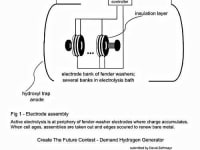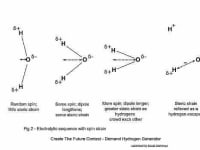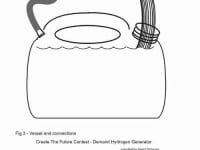The major drawback to vegetable oils as automotive fuel has been the starting-from-cold problem. Briefly introducing some low flashpoint fuel such as hydrogen, gasoline or ether is a solution that has storage difficulties.
Water is safe to store, so producing hydrogen from water only on demand is attractive. My theory and design may allow electrolysis to happen fast enough to meet the expectations of a driver seated in a car and turning the ignition key.
My early experiments with direct current through softened tap water with no added electrolytes showed rapid degradation of current, from 7A to 3A in under four seconds. I conjecture this was due to "fogging" of the E field from buildup of hydroxyl ions at the anode.
In electrolysis generally, some H+ ions meet up quickly and form H2 hydrogen gas, which comes readily out of solution for convenient delivery to the carburetor, impelled through a hose by its own gas pressure. Other new hydrogen ions recombine with hydroxyl ions as water.
I hypothesize that putting a high frequency alternating electrical field between electrodes in water would, at some empirically tuned frequencies, not only avoid electrode fogging but would set water dipoles spinning enough to drive off hydrogen ions, using less energy.
Key to the proposed pulse driver is a low duty cycle, to pump the spinning of water dipoles and not hold them in oscillation. At some optimum frequency or a submultiple thereof, pumped spin would impose steric strain and "centrifuge off" nascent H+ with less energy input than known technology.
The spin pumping frequency decreases as dipoles lengthen (from conservation of momentum), so experiment may reveal a best schedule of repeatedly starting high and ramping to lower frequency.
A separate non-pulsed (DC) getter electrode pair flushes hydroxyl ions away from hydrolysis sites and sequesters them at a getter anode. Hydrogen ions sweep in the opposite direction until they combine as H2 gas.
Assembly and wiring of electrode banks of fender washers readily lends itself to automation. A do-it-yourself hobbyist could fabricate a four-bank system with a few days' tedious soldering and applying fish-oil paint insulation. Oxidizing the washer surfaces and then scouring the edges is an option.
A vessel to contain the water and electrodes is required, of a size and shape to be located in the engine space. For a home-built system, this might be a gallon gasoline can. Wires pass through the pour opening. Hydrogen delivery hose attaches at the vacuum relief nipple. A commercial version might specify a more robust canister and a miniaturized fender washer assembly that can be reconditioned in an ultrasound jewelry cleaner.
The pulse controller is of comparable cost to the main circuit board in a low-end electronic keyboard. A hobbyist kit version is feasible.
Like this entry?
-
About the Entrant
- Name:David Zethmayr
- Type of entry:individual
- Patent status:none








